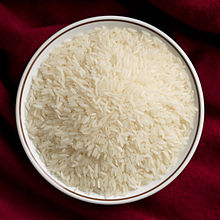Jasmine rice
| Jasmine rice | |
|---|---|
 Close-up of uncooked grains | |
| Species | Oryza sativa[1] |
| Cultivar group | Jasmine |
| Cultivar | KDML105, etc.[1] |
| Origin | Thailand |
Jasmine rice (
Jasmine rice is grown primarily in Thailand (Thai hom mali or Thai fragrant rice),[5] Cambodia (phka rumduol or Cambodian jasmine rice),[6] Laos, and southern Vietnam. It is moist and soft in texture when cooked, with a slightly sweet flavor. The grains cling and are somewhat sticky when cooked, though less sticky than glutinous rice (Oryza sativa var. glutinosa), as it has less amylopectin. It is about three times stickier than American long-grain rice.
To harvest jasmine rice, the long stalks are cut and threshed. The rice can then be left in a
Jasmine rice is not directly related to the shrub of the same name.
Origin
The origin of jasmine rice can be traced to Ban Laem Pradu in
Types
Thai jasmine rice and Cambodian rice share many of the same characteristics and grow mainly in neighboring geographic areas on opposite sides of the northeastern Thai-Cambodian border. Cambodian jasmine rice is cultivated in Cambodia and processed as white (milled and polished) and brown rice. Distinct Cambodian jasmine rice varieties include these three, phka rumduol, phka romeat, and phka rumdeng. Recent DNA fingerprint analysis, carried out with 18 markers, shows that all three varieties possess 18 known fragrance alleles.[13] Two varietals (phka rumduol and phka rumdeng) are distinctly Cambodian with 17 markers in identical positions, with Thai jasmine rice and one fragrance marker each in a different position.[citation needed] The analysis of Cambodian phka romeat shows all 18 markers in identical positions with the trademarked Thai jasmine rice Thai hom mali.[citation needed]
Jasmine rice, though grown in Laos and southern Vietnam, is not the predominant rice variety. Glutinous rice is grown in Laos, and regular Oryza sativa predominates in Vietnam.[citation needed]
Thai jasmine rice from
White jasmine rice
White rice is often preferred for taste, texture, and ease of digestion. When cooked, white jasmine rice has a dry texture.[14]: 8–13 The aroma is caused by the evaporation of 2-acetyl-1-pyrroline.[14]: 8–13
-
Steamed Jasmine rice with Holy-basil chicken stir fry
-
Thai style Khao Man Gai (Hainanese Chicken Rice)
-
Thai green curry with a side of Jasmine rice
Brown jasmine rice
Brown jasmine rice retains the light tan outer layer on the rice grain.[
Glycemic index
Jasmine rice has a
Culinary uses
Steamed jasmine rice is ideal for eating with stir fries, with grilled, fried, or braised food items, and in soups (when cooked slightly drier by adding a little less water during cooking).
Jasmine rice is frequently served at Thai and Vietnamese restaurants worldwide. It is not the rice traditionally used in Indian, Chinese, or European dishes.
Recognition
At the 2017 World Rice Conference held in Macau, Thailand's hom mali 105 (jasmine) rice was declared the world's best rice, beating 21 competitors.[20] Thailand had entered three rice varieties in the competition. This marked the fifth time in the prior nine years that Thai jasmine rice has won the honour.[21] The judges of the competition were chefs from Macau restaurants. Criteria were taste and the shape of the rice grains. Cambodia finished second, Vietnam third.[22]
See also
- Ambemohar
- Basmati rice
- Glutinous rice
- List of rice varieties
- Oryza sativa
- Riceberry: A Thai rice variety that is a cross-breed of Jao Hom Nin and Khao Dok Mali 105
- Thung Kula Ronghai: Well-known Thai Hom Mali growing region
- Wehani rice
References
- ^ PMID 30718781.
- .
- PMID 12517110.
- ^ Gershenson, Lisa (Winter 2015). "New Crop Rice". Cook's Gazette. Retrieved February 2, 2016.
- ^ Somnuk, Weerawat; Buddhajak, Smanachan; Sunsuk, Donlawat; Saefad, Somchai (28 February 2021). "The Struggle of Thung Kula Rice Farmers to Grow Hom Mali Rice". Prachatai English. Retrieved 30 March 2021.
- ^ Kossov, Igor (5 May 2015). ""World's Best Rice" Struggles for Recognition". Khmer Times. Retrieved 30 March 2021.
- ^ Thai Rice for Life (PDF), Department of Foreign Trade, Ministry of Commerce, October 2016, p. 82 – via Sirivatana Interprint
- S2CID 167540903.
- ^ Nipaporn Chaisri; Kritsada Srituptim; Intira Khemmuang; Varuni Permsap (July 2021), Study efficiency of bio-fertilizer to increase growth and rice (Khao Dawk Mali 105) yield in Sandy Loam soil, Surin Province (in Thai), Land Development Department, p. 7, archived from the original on 2023-02-19, retrieved 2023-02-19
- ^ Prof. Dr. Peeradej Thongampai (November 14, 2016). "ตำนานข้าวหอมไทย (จบ)". Komchadluek (in Thai).
- ^ Suksan Suthiphonphaiboon, ความหอมของข้าวหอมมะลิ (PDF) (in Thai), Ministry of Agriculture and Cooperatives
- S2CID 255587543.
- ^ カンボジア農業開発研究所 (2013-11-12). "Aromatic Authenticity to Jasmine Rice Type and Fragrance Genes Analysis". Retrieved 2019-07-08.
- ^ a b c K. Khunket; A. Wutthanet; A. Prasertsak; S. Traprap. ข้าวขาวดอกมะลิ 105. กรมการข้าว สำนักวิจัยและพัฒนาข้าว.
- ^ W. Leanjumroon, N. Yuwanaboon. หอมกลิ่นข้าวมะลิหอม. BIOTHAI. p. 10.
- ^ Yongcharoenchai, Chaiyot (6 November 2016). "The Rice Man Cometh". Bangkok Post. Retrieved 10 November 2016.
- ^ "Benefits of Brown jasmine rice". Manob Keawsanid. Archived from the original on December 28, 2013. Retrieved October 20, 2013.
- PMID 24885045.
- PMID 12792658.
- ^ Arunmas, Phusadee (8 November 2017). "It's official: Thai rice is the world's best". Bangkok Post. Retrieved 13 November 2017.
- ^ "The 9th Annual – World's Best Rice Contest 2017". 9th Annual World Rice Conference. The Rice Trader. Archived from the original on 28 August 2018. Retrieved 13 November 2017.
- ^ "Thai jasmine rice named the world's best rice". Samui Times. n.d. Archived from the original on 17 November 2019. Retrieved 24 November 2017.
- 1. 1'Dawk' and 'Dok' are alternative spellings of the same Thai word, which is pronounced similarly. 'Dawk' is more commonly used than 'Dok' and both mean 'flower' in Thai.
External links
- "Jasmine Rice: Thailand's Honorable Grain". Thailand Foundation. 2021-09-20. Retrieved 2022-07-05.



